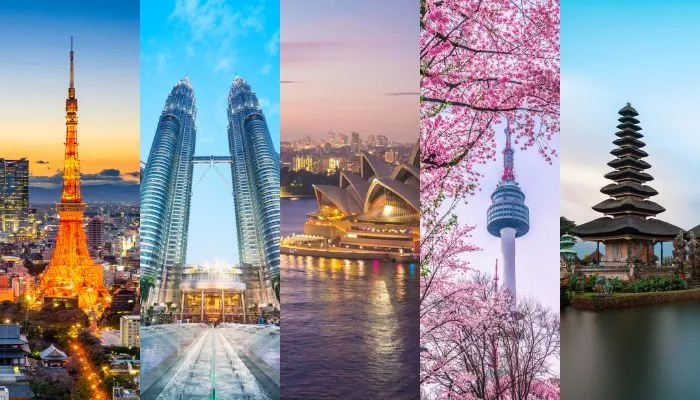Singapore –Asia-Pacific destinations now occupy half of the top 10 trending hot spots that have demonstrated the greatest momentum among travellers, the report from the Mastercard Economics Institute showed.
According to the report, APAC is home to half of the world’s top 10 trending tourism destinations, with Japan emerging at first, followed by Malaysia on sixth, Australia on seventh, South Korea on eighth, and Indonesia on tenth. This is measured and ranked by the change in share of tourism transactions over the past 12 months ending March 2024.
Japan tops the trending list worldwide after welcoming a record-breaking 3 million visitors from abroad in March 2024. This is by far the country’s highest level ever, a huge feat considering the numbers are recorded even before the peak travel season begins.
The country’s favourable exchange rate is expected to help it remain the clear tourism frontrunner throughout 2024, benefiting Japanese businesses catering to tourists and the local economy overall.
While APAC’s trending destinations continue to capture attention, Mastercard reports a notable rebound in passenger traffic, especially for shorter, intra-regional trips to top summer spots like Bangkok, Kuala Lumpur, and Perth. Consequently, Thailand’s tourism is poised for a full recovery in 2024, with visitor arrivals now just 7% below pre-pandemic levels in 2019. Bangkok currently sits at number 7 among the summer holiday hot spots, ranking behind Bali at six and Tokyo, which is leading in APAC at second.
The report also recorded Chinese mainland domestic tourism rebounding while outbound travel continues to recover. The country’s travel dynamic has been affected by more Chinese tourists prioritising domestic trips over international ones. As of writing, international tourism traffic leaving the Chinese mainland continues to recover and is now at 80.3% of 2019 levels.
And while outbound travel from the Chinese mainland continues to recover, the report also revealed that more Indians are travelling than at any time in history. In the first three months of 2024, 97 million passengers travelled through Indian airports, a figure that would’ve taken a whole year to achieve 10 years ago. This rise in figures is driven by a burgeoning middle class, additional route capacity, and a strong desire to travel.
Another interesting piece of data Mastercard’s report has unveiled is that travellers to APAC are vacationing longer and prioritising experiences over purchases. Excluding ANZ, tourists in APAC in 2024 are extending their trips by an average of 1.2 days to a total duration of 7.4 days, motivated by the affordability of destinations, warm weather, and favourable exchange rates.
Among the APAC destinations with the longest increase in trip duration between 2019 and 2024 are India (+2 days), Vietnam (+2 days), Indonesia (+1.9 days), and Japan (+1.4 days), largely due to their lower growth in hotel prices during this period compared to other markets. This longer stay generally translates to more spending per trip, which benefits local economies.
Consumers globally are also continuing to prioritise experiences over material goods. This is playing out in the travel sector, as spending on experiences and nightlife totals 12% of tourism sales—the highest point in at least five years. Meanwhile, retail shopping is recovering at a slower pace.
Australian tourists are found to be the highest spenders globally on experiences and nightlife. In 2024, Aussies will spend one of every five dollars (19%) on these activities, significantly higher than the global average (12%). Tourists from the Chinese mainland are also increasingly seeking out experiences, spending 10% on this category in 2024, up from 7% in 2023.
Finally, Mastercard’s report reveals that while tourists today generally favour laid-back vibes, they still seek out luxury retail and fine dining when these offer exceptional value for money. Notably, luxury fashion sales saw a significant year-over-year increase in the year ending March 2024, with Japan experiencing a 152% rise and Hong Kong SAR a remarkable 208% surge. Hong Kong SAR’s late reopening in 2023 contributed to its growth, whereas Japan’s increase is driven by a weak yen and strong inbound tourism.
Australia, India, and Thailand now enjoy burgeoning fine dining scenes, leading to premium dining outperformance compared to casual dining, which remains dominant elsewhere.
David Mann, chief economist for Asia Pacific at Mastercard, said, “Consumers in the Asia Pacific region have an intense desire and willingness to travel and are becoming increasingly savvy to ensure they get the best value and unforgettable experiences from their trips. For tourism authorities, retailers, and the hospitality and F&B sectors, the bottom line is that costs matter. In today’s economy, foreign exchange rates and spending power have become vital components in driving a traveller’s assessment of value when they are making their plans. This suggests that businesses targeting tourism dollars need to review their current strategies and shift them if necessary to maintain their appeal to travellers.”
“Amidst the evolving tourism landscape and continuing surge in travel throughout 2024, the Mastercard Economics Institute aids businesses and policymakers in translating macroeconomic forces and data insights into actionable strategies at the country, category, and company levels, in addition to counselling on possible scenarios and the implications they have on demand,” he added.

